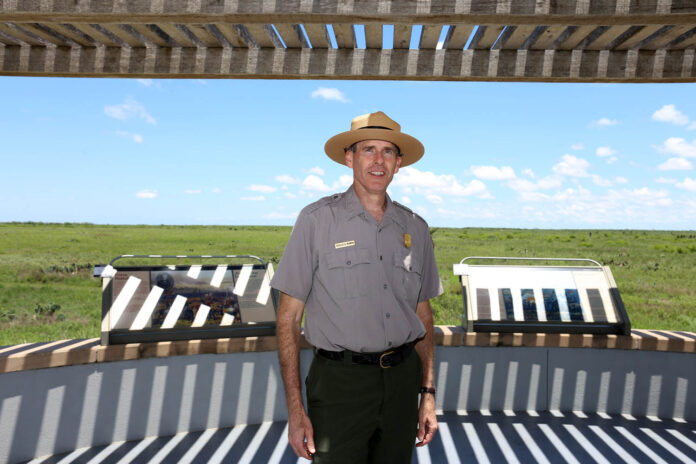For over 25 years, National Park Ranger historian and nationally-recognized military author, Douglas A. Murphy has served at the Palo Alto Battlefield National Historic Park, the only federally-protected site from the U.S.-Mexican War.
The Palo Alto Battlefield was declared a national park in 1991, and last year, welcomed 82,500 visitors to the park.
Murphy, the last member of the original park staff, served as the park’s Chief of Operations, and helped the park grow from its origins as a National Historic Site into a fully operational multi-unit National Historical Park. Murphy has given numerous presentations in the Brownsville area to local clubs and organizations over his 26-year career with NPS.
That career came to an end as Murphy’s last day was June 15.
As Chief of Interpretation, Murphy created three generations of park museum exhibits, and designed and created content for park wayside exhibits. The 3,400 acre site covered by the Palo Alto Battlefield encompasses the wide coastal prairie, areas of dense brush, wetlands, and the great variety of plants and animals abundant in South Texas.
“When I was Chief of Interpretation, my main focus was education and public outreach,” Murphy said, “I always felt it was as important how I presented the park, as well as the information I presented.”
Although the primary purpose of the park is to interpret the 1846 battle, many of the wayside exhibits feature the natural scenes of the modern era, drawing attention to some of the common birds, plants, and animals that inhabit the broad, flat plain.
“This is such a unique area,” Murphy said, “and when I first started back in 1993, I felt that story had not been told very well. So I decide to take up that challenge.”
The low-lying, coastal prairie of Palo Alto was, at the time of the battle, surrounded by tree-covered rises that inspired its Spanish name, “Tall Timber,” and was naturally suited for the first battle of the Mexican War. The Matamoros-to-Point Isabel road crossed the vast field on the western end, and was the very road General Zachary Taylor’s force of 2,300 men and 400 wagons were following.
Murphy, who earned a PhD in History from the University of North Carolina, Chapel Hill was in Matamoros working on research for his advanced degree when he got the call from the Superintendent of Palo Alto back in 1992.
“For me, it was intriguing when I considered that a position with the National Park Service would allow me the opportunity to be able to utilize not only my background in history, but I would be able to do a little bit of everything, including archeology, and continue with my research,” Murphy said.
He continued, “I think everyone should find a job that meets some of the criteria of what they feel they want to do with their lives.”
Over 100 years ago, jaguars and ocelots used to roam freely under the canopy of the subtropical riparian forest, but this area of land along the Rio Grande has been cleared to build dams and reservoirs for flood control, agriculture, and municipal uses destroying the wild cats’ natural habitat. These animals are on the threatened and endangered lists, and sightings are a rare occurrence.
Murphy recalled working late one night when a nilgai antelope peeked into his office window.
“I suppose he was attracted by the light in my office, and just curious enough to look in and watch while I was working on my computer,” Murphy said.
At a recent farewell party, which according to Murphy was “more like a ‘roast’,” Superintendent of the Palo Alto Battlefield, Mark Spier, commented, “Doug is the only guy who really knows where all the bodies are buried.” he joked.
“Well,” Murphy retorted, “I know where they should be buried.”
Spier later commented, “I can seriously say that Doug has a passion for history and for sharing that passion with the public, as evidenced by the books he’s written, as well as all the museum exhibits, programs, special events and other works he’s produced for Palo Alto over the years.
“Doug deeply cares about Palo Alto, he cares about always ‘getting it right,’ and he cares about the details,” Spier says. “By his example, Doug helped us all raise the bar.”





